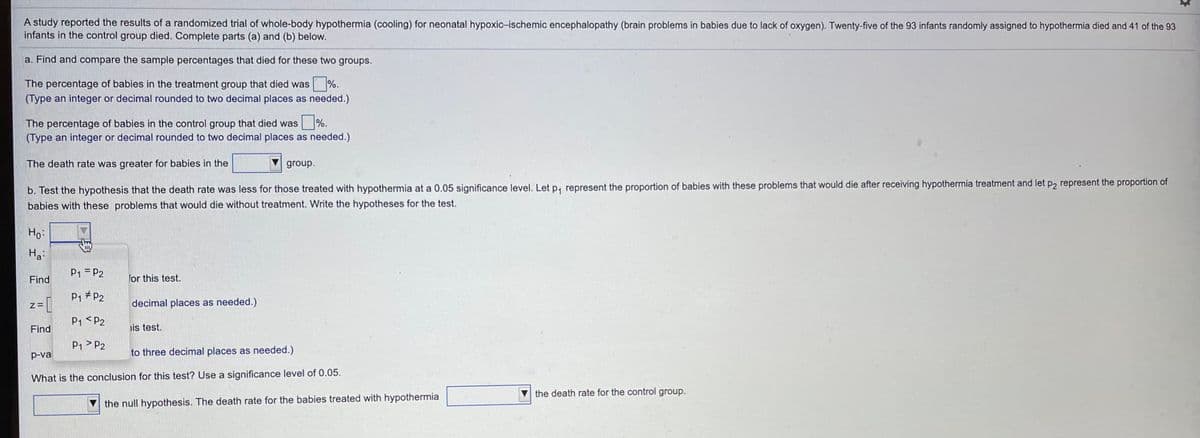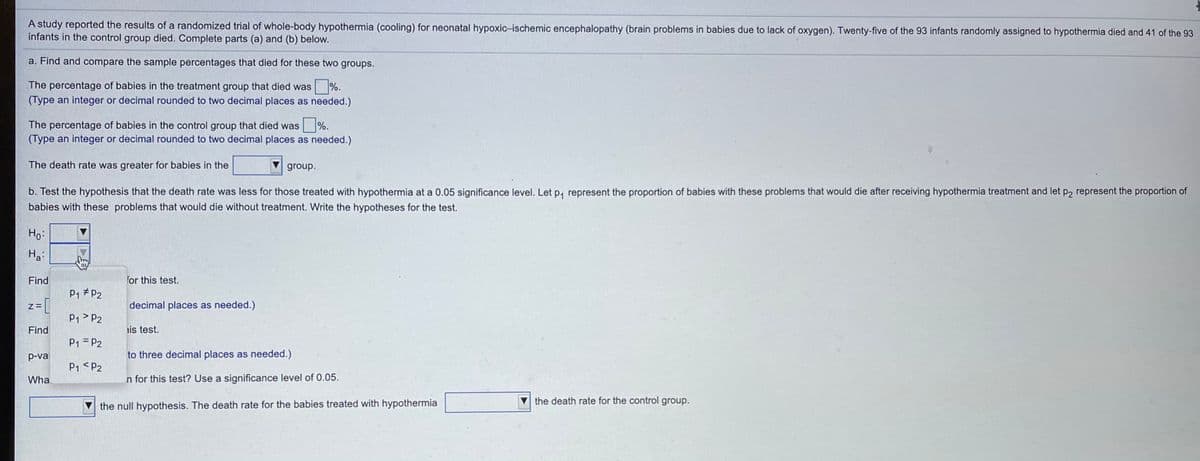A study reported the results of a randomized trial of whole-body hypothermia (cooling) for neonatal hypoxic-ischemic encephalopathy (brain problems in babies due to lack of oxygen). Twenty-five of the 93 infants randomly assigned to hypothermia died and 41 of the 93 infants in the control group died. Complete parts (a) and (b) below. a. Find and compare the sample percentages that died for these two groups. The percentage of babies in the treatment group that died was%. (Type an integer or decimal rounded to two decimal places as needed.) The percentage of babies in the control group that died was% (Type an integer or decimal rounded to two decimal places as needed.) The death rate was greater for babies in the V group. b. Test the hypothesis that the death rate was less for those treated with hypothermia at a 0.05 significance level. Let p, represent the proportion babies with these problems that would die after receiving hypothermia treatment and let p, represent the proportion of babies with these problems that would die without treatment. Write the hypotheses for the test. Ho H.: P: =P2 Find lor this test. P, P2 decimal places as needed.) P1 P2 p-va to three decimal places as needed.) What is the conclusion for this test? Use a significance level of 0.05. V the death rate for the control group. the null hypothesis. The death rate for the babies treated with hypothermia
A study reported the results of a randomized trial of whole-body hypothermia (cooling) for neonatal hypoxic-ischemic encephalopathy (brain problems in babies due to lack of oxygen). Twenty-five of the 93 infants randomly assigned to hypothermia died and 41 of the 93 infants in the control group died. Complete parts (a) and (b) below. a. Find and compare the sample percentages that died for these two groups. The percentage of babies in the treatment group that died was%. (Type an integer or decimal rounded to two decimal places as needed.) The percentage of babies in the control group that died was% (Type an integer or decimal rounded to two decimal places as needed.) The death rate was greater for babies in the V group. b. Test the hypothesis that the death rate was less for those treated with hypothermia at a 0.05 significance level. Let p, represent the proportion babies with these problems that would die after receiving hypothermia treatment and let p, represent the proportion of babies with these problems that would die without treatment. Write the hypotheses for the test. Ho H.: P: =P2 Find lor this test. P, P2 decimal places as needed.) P1 P2 p-va to three decimal places as needed.) What is the conclusion for this test? Use a significance level of 0.05. V the death rate for the control group. the null hypothesis. The death rate for the babies treated with hypothermia
Holt Mcdougal Larson Pre-algebra: Student Edition 2012
1st Edition
ISBN:9780547587776
Author:HOLT MCDOUGAL
Publisher:HOLT MCDOUGAL
Chapter11: Data Analysis And Probability
Section: Chapter Questions
Problem 8CR
Related questions
Question
Help with entire question please. The last selections in part a) are "treatment or control"
the last two selections for part b) are " reject, or do not reject" for the last one they are "greater than, was the same as, was less than, or was different from"

Transcribed Image Text:A study reported the results of a randomized trial of whole-body hypothermia (cooling) for neonatal hypoxic-ischemic encephalopathy (brain problems in babies due to lack of oxygen). Twenty-five of the 93 infants randomly assigned to hypothermia died and 41 of the 93
infants in the control group died. Complete parts (a) and (b) below.
a. Find and compare the sample percentages that died for these two groups.
The percentage of babies in the treatment group that died was %.
(Type an integer or decimal rounded to two decimal places as needed.)
The percentage of babies in the control group that died was %.
(Type an integer or decimal rounded to two decimal places as needed.)
The death rate was greater for babies in the
group.
b. Test the hypothesis that the death rate was less for those treated with hypothermia at a 0.05 significance level. Let p, represent the proportion of babies with these problems that would die after receiving hypothermia treatment and let p, represent the proportion of
babies with these problems that would die without treatment. Write the hypotheses for the test.
Ho:
Ha:
P1 = P2
Find
for this test.
P1 # P2
decimal places as needed.)
P1 < P2
Find
is test.
P1> P2
p-val
to three decimal places as needed.)
What is the conclusion for this test? Use a significance level of 0.05.
the death rate for the control group.
the null hypothesis. The death rate for the babies treated with hypothermia

Transcribed Image Text:A study reported the results of a randomized trial of whole-body hypothermia (cooling) for neonatal hypoxic-ischemic encephalopathy (brain problems in babies due to lack of oxygen). Twenty-five of the 93 infants randomly assigned to hypothermia died and 41 of the 93
infants in the control group died. Complete parts (a) and (b) below.
a. Find and compare the sample percentages that died for these two groups.
The percentage of babies in the treatment group that died was
%.
(Type an integer or decimal rounded to two decimal places as needed.)
The percentage of babies in the control group that died was
%.
(Type an integer or decimal rounded to two decimal places as needed.)
The death rate was greater for babies in the
group.
b. Test the hypothesis that the death rate was less for those treated with hypothermia at a 0.05 significance level. Let p, represent the proportion of babies with these problems that would die after receiving hypothermia treatment and let p2 represent the proportion of
babies with these problems that would die without treatment. Write the hypotheses for the test.
Ho:
Ha
Find
for this test.
P1 # P2
decimal places as needed.)
P1 > P2
Find
is test.
P1 = P2
p-val
to three decimal places as needed.)
P1 <P2
Wha
n for this test? Use a significance level of 0.05.
the death rate for the control group.
the null hypothesis. The death rate for the babies treated with hypothermia
Expert Solution
This question has been solved!
Explore an expertly crafted, step-by-step solution for a thorough understanding of key concepts.
This is a popular solution!
Trending now
This is a popular solution!
Step by step
Solved in 2 steps

Knowledge Booster
Learn more about
Need a deep-dive on the concept behind this application? Look no further. Learn more about this topic, statistics and related others by exploring similar questions and additional content below.Recommended textbooks for you

Holt Mcdougal Larson Pre-algebra: Student Edition…
Algebra
ISBN:
9780547587776
Author:
HOLT MCDOUGAL
Publisher:
HOLT MCDOUGAL

Glencoe Algebra 1, Student Edition, 9780079039897…
Algebra
ISBN:
9780079039897
Author:
Carter
Publisher:
McGraw Hill

Holt Mcdougal Larson Pre-algebra: Student Edition…
Algebra
ISBN:
9780547587776
Author:
HOLT MCDOUGAL
Publisher:
HOLT MCDOUGAL

Glencoe Algebra 1, Student Edition, 9780079039897…
Algebra
ISBN:
9780079039897
Author:
Carter
Publisher:
McGraw Hill